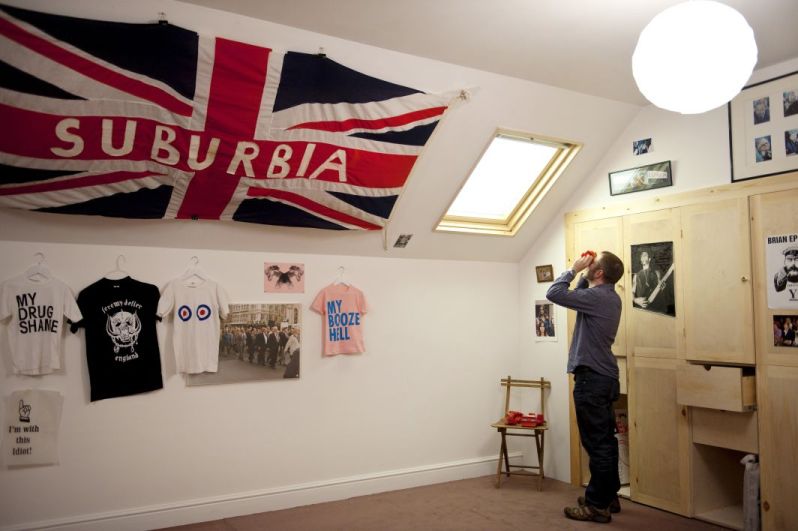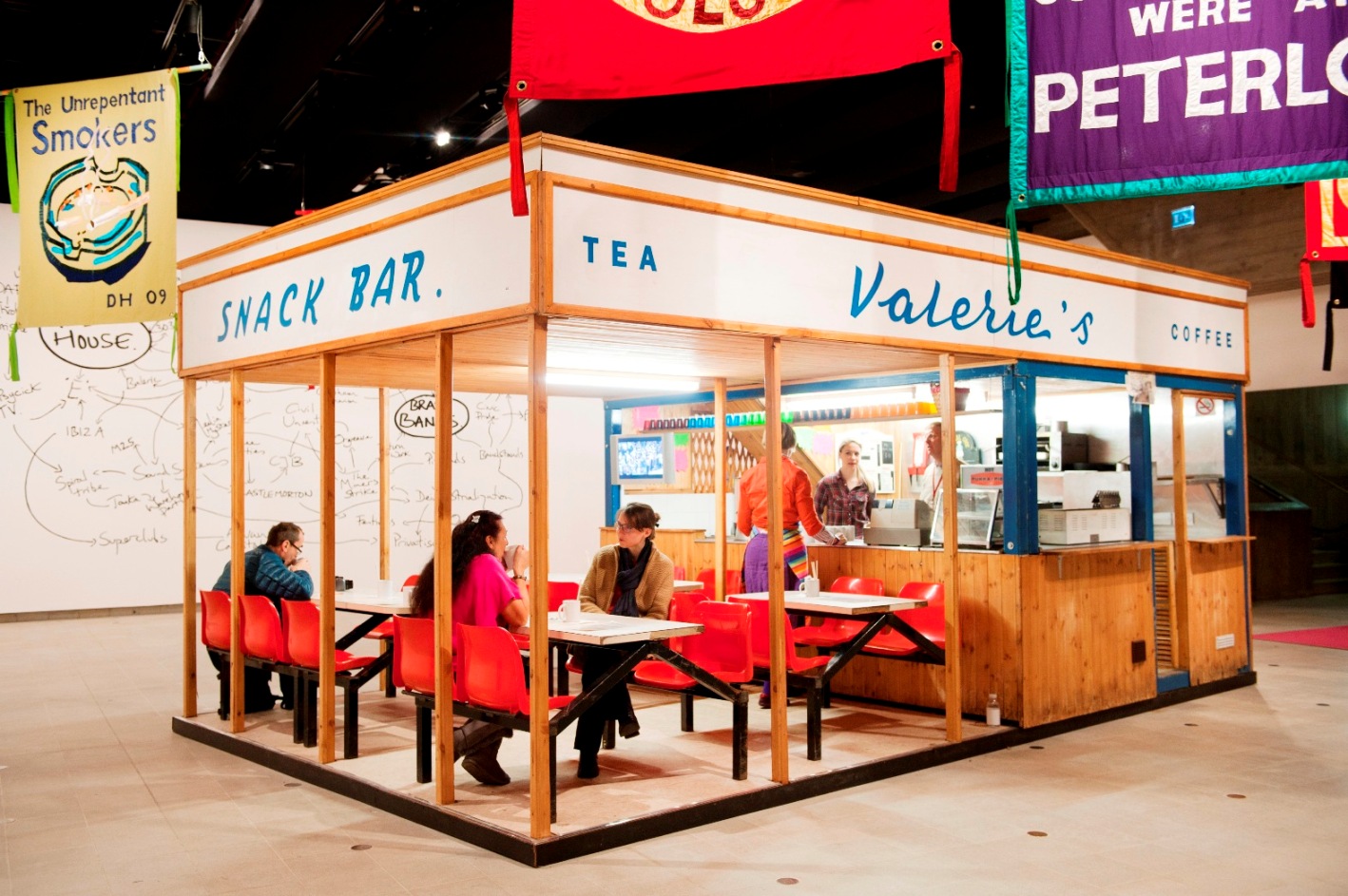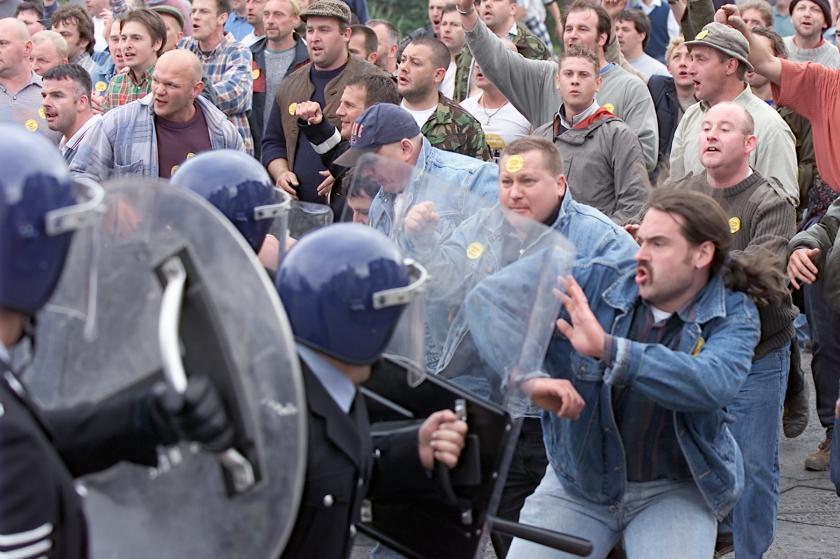As he readily acknowledges himself, Jeremy Deller can’t paint and he can’t draw, so he never went to art school. For many artists of his generation (he’s 46), this lack of traditionally based skills seems not to have presented a problem. But Deller clearly isn’t one for trying to be good at things he’s so self-evidently bad at, so instead of going to art school he studied art history, and then began to follow his interests. Luckily for him, and us, all the stuff that interests him falls within the periphery of what one might call art.
Deller’s interests are diverse, but are primarily based on an interest in people and in communities. He also likes collecting things, archiving things and facilitating “happenings” or performances. These “happenings” seem not to have anything in common with what one might usually associate with the term – firstly because they’re so highly structured, and secondly because they involve ordinary people and not art people. And because there’s nothing alienatingly avant-garde or confrontational about them they present an ideal of Nineties inclusivity rather than Sixties radicalism. Plus they’re incredibly ambitious in scale.
Deller has a remarkable talent for homing in on events that have resonance in the collective memory
The work for which Deller is best known is his 2001 performative piece, The Battle of Orgreave (main picture), which was the full-scale re-enactment of the violent clash between police and striking miners that took place in 1984 during the miner’s strike. Complete with a timeline of the key events of the strike – which is utterly absorbing – this forms the centrepiece of a survey that takes us from a loose reconstruction of Deller’s very first “exhibition” in 1993, held in his old, preternaturally tidy bedroom at his parents' house while they were away (posters, printed T-shirts, a homage to Keith Moon: reconstruction pictured below), to his latest work, Exodus, a 3D film showing thousands of bats swarming out of a cave as dusk descends.
 This latest work returns Deller to the climactic scene of Memory Bucket, his 2003 Turner Prize-winning film surveying the landscape and some of the communities of Waco, Texas, a city that provided the home and official base for George W. Bush during his presidency but which gained particular notoriety for its association with David Koresh, the Branch Davidians and the 1993 hostage siege that ended in conflagration and the deaths of 74 people. It’s a work that amply demonstrates the key thing about Deller, of just why the idea – so audacious and so imaginative that you wonder just why nobody has ever thought to do it in quite that way before – is often far more powerful than the execution.
This latest work returns Deller to the climactic scene of Memory Bucket, his 2003 Turner Prize-winning film surveying the landscape and some of the communities of Waco, Texas, a city that provided the home and official base for George W. Bush during his presidency but which gained particular notoriety for its association with David Koresh, the Branch Davidians and the 1993 hostage siege that ended in conflagration and the deaths of 74 people. It’s a work that amply demonstrates the key thing about Deller, of just why the idea – so audacious and so imaginative that you wonder just why nobody has ever thought to do it in quite that way before – is often far more powerful than the execution.
Deller has a remarkable talent for homing in on events that have particular resonance in the collective memory – staging mass street parades, getting Manic Street Preacher fans to pour out their feelings of identification with their idols, being wittily subversive by responding to a London Underground commission with a picture of a bicycle executed in the colours of an underground map, typing out the erudite graffiti found on the walls of the British Library and sticking it all on the walls of an installed toilet.
 But we don’t really need to be there to appreciate what it’s doing and how it’s working on us. In fact, the work often absorbs us more satisfactorily as a heady conceit than as something that can be properly appreciated in the real world – Deller, it seems, might just be the Borges of contemporary art, and these works really exist best in a kind of parallel universe of the mind, where they have just enough room to expand and enrich.
But we don’t really need to be there to appreciate what it’s doing and how it’s working on us. In fact, the work often absorbs us more satisfactorily as a heady conceit than as something that can be properly appreciated in the real world – Deller, it seems, might just be the Borges of contemporary art, and these works really exist best in a kind of parallel universe of the mind, where they have just enough room to expand and enrich.
And who doesn’t love the idea of Procession (2009), in which numerous “outsider” groups were invited to participate in a big street parade, from Big Issue vendors and Emos to buskers and unrepentant smokers? Or the almost exact replica of Valerie’s Snack Bar – a youth club for OAPs, as Deller describes it – which was put on the back of a lorry and given a spin as part of the whole jamboree? You’ll find it parked up at the Hayward where it serves real tea (so English and reassuring in its cosy eccentricities – conceptual art, but not as we usually know it).
All this explains why a gallery just isn’t the best place to appreciate what Jeremy Deller does; there’s something almost inevitable about its disappointment. And like his lack of drawing skills, Deller probably knows this himself.
- Jeremy Deller: Joy in People at the Hayward Gallery until 13 May









![SEX MONEY RACE RELIGION [2016] by Gilbert and George. Installation shot of Gilbert & George 21ST CENTURY PICTURES Hayward Gallery](/sites/default/files/styles/thumbnail_125_x_125_/public/mastimages/Gilbert%20%26%20George_%2021ST%20CENTURY%20PICTURES.%20SEX%20MONEY%20RACE%20RELIGION%20%5B2016%5D.%20Photo_%20Mark%20Blower.%20Courtesy%20of%20the%20Gilbert%20%26%20George%20and%20the%20Hayward%20Gallery._0.jpg?itok=3oW-Y84i)





Add comment